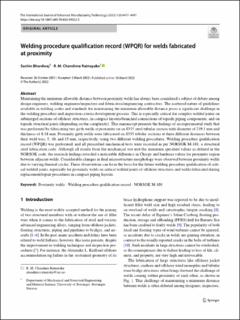| dc.contributor.author | Bhardwaj, Sachin | |
| dc.contributor.author | RATNAYAKE MUDIYANSELAGE, Chandima | |
| dc.date.accessioned | 2023-02-17T15:27:36Z | |
| dc.date.available | 2023-02-17T15:27:36Z | |
| dc.date.created | 2022-03-16T11:02:07Z | |
| dc.date.issued | 2022 | |
| dc.identifier.citation | Bhardwaj, S., & Ratnayake, R. C. (2022). Welding procedure qualification record (WPQR) for welds fabricated at proximity. The International Journal of Advanced Manufacturing Technology, 120(7-8), 4477-4491. | en_US |
| dc.identifier.issn | 0268-3768 | |
| dc.identifier.uri | https://hdl.handle.net/11250/3052100 | |
| dc.description.abstract | Maintaining the minimum allowable distance between proximity welds has always been considered a subject of debate among design engineers, welding engineers/inspectors and fabricators/engineering contractors. The scattered nature of guidelines available in welding codes and standards for maintaining the minimum allowable distance poses a significant challenge in the welding procedure and inspection criteria development process. This is especially critical for complex welded joints on submerged sections of offshore structures, in compact layouts/branched connections of topside piping components, and on topside structural joints (depending on the complexity). This manuscript presents the findings of an experimental study that was performed by fabricating two girth welds at proximity on an S355 steel tubular section with diameter of 219.1 mm and thickness of 8.18 mm. Proximity girth welds were fabricated on S355 tubular sections at three different distances between their weld toes, 5, 10, and 15 mm, respectively, using two different welding procedures. Welding procedure qualification record (WPQR) was performed, and all prescribed mechanical tests were recorded as per NORSOK M-101, a structural steel fabrication code. Although all results from the mechanical test met the minimum specified values as defend in the NORSOK code, the research findings revealed a noticeable difference in Charpy and hardness values for proximity region between adjacent welds. Considerable changes in final microstructure morphology were observed between proximity welds due to varying thermal cycles. These observations can form the basis for the future welding procedure qualification of critical welded joints, especially for proximity welds on critical welded joints of offshore structures and welds fabricated during replacement/repair procedures in compact piping layouts. | en_US |
| dc.description.abstract | Welding procedure qualification record (WPQR) for welds fabricated at proximity | en_US |
| dc.language.iso | eng | en_US |
| dc.publisher | Springer | en_US |
| dc.rights | Navngivelse 4.0 Internasjonal | * |
| dc.rights.uri | http://creativecommons.org/licenses/by/4.0/deed.no | * |
| dc.title | Welding procedure qualification record (WPQR) for welds fabricated at proximity | en_US |
| dc.title.alternative | Welding procedure qualification record (WPQR) for welds fabricated at proximity | en_US |
| dc.type | Peer reviewed | en_US |
| dc.type | Journal article | en_US |
| dc.description.version | publishedVersion | en_US |
| dc.rights.holder | The authors | en_US |
| dc.subject.nsi | VDP::Teknologi: 500 | en_US |
| dc.source.journal | The International Journal of Advanced Manufacturing Technology | en_US |
| dc.identifier.doi | 10.1007/s00170-022-09022-5 | |
| dc.identifier.cristin | 2010155 | |
| cristin.ispublished | true | |
| cristin.fulltext | original | |
| cristin.qualitycode | 2 | |

